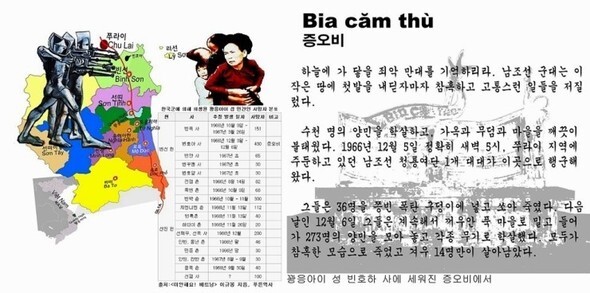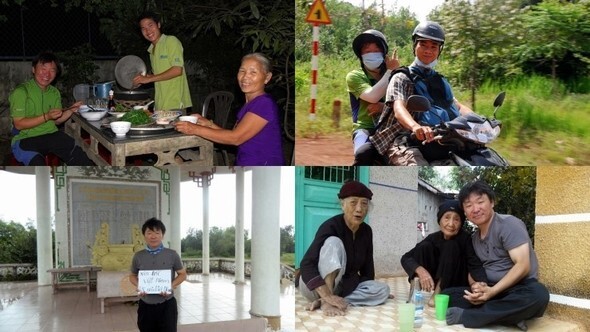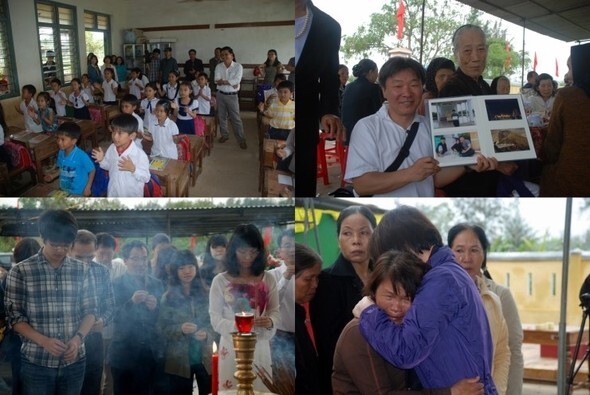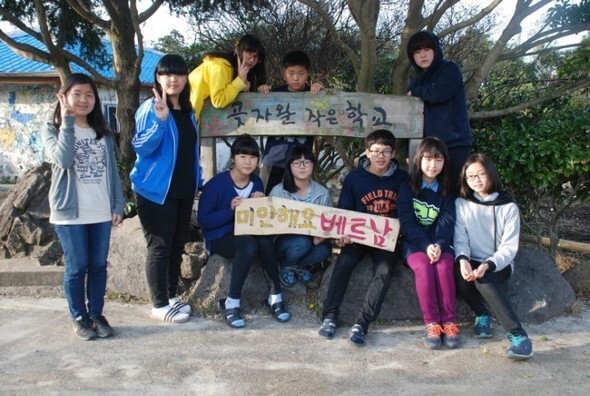hankyoreh
Links to other country sites 다른 나라 사이트 링크
[Special reportage- part III] The South Korean Vietnam War experience

By Nam Jong-young, staff reporter
“To the enemy, let us be a bold and fearsome South Korean Army. To the Vietnamese, let us be well-mannered and kind Dai Han,” reads one of the “three instructions and five warnings” for the South Korean forces in Vietnam.
The reality was somewhat different. The forces were like astronauts who had landed on a strange planet. They lost their way following faint trails in the jungle; they fumbled with rice urns and metal cooking pots in the village to find a place to store secret supplies. It took them some time to learn about the mazelike network of caves and tunnels dug into the ground beneath them.
When the first South Korean combat forces were deployed to South Vietnam in 1965, the guerrillas of the Viet Cong (National Liberation Front) had already established a base there and had political control of the locals. Like the US forces, the South Korean soldiers had a difficult time distinguishing who was an enemy soldier and who was an ordinary civilian. Boundaries were often unclear. Residents were friendly during the day, but could be deadly at night.
Many of the civilian massacres took face just after the Tet Offensive in January and February 1968. Around the same time, Pamtihoa, who passed away on June 16 at age 87, lost her legs in a South Korean offensive. On Jan. 31 of that year, the North Vietnamese and Viet Cong launched a massive offensive in major cities in fourteen provinces during the Tet (Lunar New Year) celebration, for which a ceasefire agreement had been in place. The US and South Korean forces soon hit back, but the numerous casualties helped fan criticisms at home for the US, and North Vietnam emerged with the initiative in the conflict.

There was then a new tactic for dealing with the Viet Cong: stripping away their base for guerrilla activity. To deprive them of chances for contacting the guerrillas, villagers were removed from natural settlements and placed in resettlement villages.
The mindset was already evident in the manual published by the South Korean Forces Command in 1966. Villages, soldiers were told, were “the base for all enemy activity.”
“Villages are the origin for guerrilla supply, human resources, and intelligence collection,” the manual read. “The base for the Viet Cong understructure is the villages and their residents.”
Residents of the villages where civilian massacres took place recounted scenes of ghastly cruelty and carnage. How could that have happened? According to Sungkonghoe University professor Han Hong-gu, South Koreans were in the grip of an extreme form of right-wing anti-Communism, the product of their own modern historical experience. The postwar division of the Korean Peninsula and the intense antagonisms both with North Korea and at home gave rise to a kind of “punish the commies” psychological mechanism. People could perpetrate horrible atrocities while neutralizing any sense of guilt. Said one professor, “After the South Korean forces were attacked, I think a desire for revenge played a big part.”
It was a practice that had already been adopted on and around the Korean Peninsula: dealing with an “internal enemy” in a war without frontlines. Similar scenes to the Vietnamese massacre had happened when the Japanese army put down an armed rebellion in Manchuria during the 1930s, or when South Korean “partisans” were massacred at Mt. Jiri during and after the Korean War. In the latter case, residents were relocated from mountain villages with ties to the partisans, cutting off supply line before a massive mop-up operation.
Articles about the tactics appeared in the New York Times in 1970, but in South Korea it remained taboo to talk about the forces’ slaughter of civilians in Vietnam. It was only in 1999, the year after the first non-conservative administration in South Korean history took power, that the issue began to enter the public consciousness, due in part to a report in the Hankyoreh 21 magazine.
Ku Su-jeong, a contributor for Hankyoreh 21 who was staying in Vietnam at the time, sifted through Vietnamese government documents and gathered testimony from people in the villages of the five central provinces (Khanh Hoa, Binh Dinh, Phu Yen, Quang Ngai, and Quang Nam) where the ROK military carried out its search-and-destroy operations against the Viet Cong. The Vietnamese government estimates that these operations resulted in 5,000 victims.
The next year, Kim Gi-tae, a former lieutenant colonel who had participated in the war, gave his testimony. In June 2002, massacres that took place at Phong Nhi and Phong Nhat (Feb. 12, 1968), Hoan Chau (Oct. 22, 1968), and Phuoc My (Apr. 15, 1969) came to light through the declassification of documents at the US National Archives and Records Administration (NARA).

The massacres of Vietnamese civilians perpetrated by the South Korean military became an international issue. When then Vietnamese President Tran Duc Luong visited South Korea in 2001, then South Korean President Kim Dae-jung told him, “I am sorry about the fact that we took part in an unfortunate war and unintentionally created pain for the people of Vietnam.”
While there was no specific reference to the civilian massacres, this was taken as an indirect apology for them. The next day, Park Geun-hye released a private statement in which she asserted that Kim’s remarks “drove a stake through the honor of South Korea.” At the time, Park was deputy leader of the Grand National Party, the opposition party at the time (and the predecessor of today’s ruling Saenuri Party).
But Kim’s apology was not a product of diplomatic negotiations between South Korea and Vietnam. Since the issue of wartime reparations was omitted when Seoul and Hanoi established diplomatic relations in 1992, the question of the war had never been on the bilateral agenda. Not only did Vietnam generally associate the war with the US, but it had also been victorious in the war.
These Vietnamese attitudes persist today. The two countries do not feel the need to investigate the massacre of civilians. Therefore, the massacre of civilians during the Vietnam War is close to an “incomplete truth.”
In contrast, it was people from civic organizations who attempted to get closer to the truth. Starting in 1999, a peace movement got underway with the establishment of the Committee for Finding the Truth about Massacres of Vietnamese Civilians, the Committee for the Truth about Vietnam, and the Committee for Promoting the Construction of the Peace Museum.
The Peace Museum was established through a donation from Mun Myeong-geum, who as a former comfort woman was herself a victim of war. Since the early 2000s, the museum has done a variety of projects, including establishing a museum for children in Vietnam and providing scholarships.
The Medical Federation for Peace in Vietnam, which is made up of dentists and practitioners of traditional Korean medicine, sends representatives to Vietnam each year to provide medical care. The Group of Citizens Thinking about Vietnam and South Korea, which was started spontaneously on Facebook, is raising a scholarship fund for villages that were affected. The peace movement that began in Vietnam has expanded into people’s everyday lives.
“These children are the last Koreans that Pamtihoa met before she passed away. They cried when they heard about what happened 35 years ago,” said Kim Hyeon-ah, a teacher with RoadSchola, an alternative, travel-based school, on July 3. Each year, children from the school travel to Vietnam for one month. One thing that is always part of their itinerary is a stop to the site of civilian massacres. In April, 13 students visited Ha My village.
The children also had a chance to see a “monument of hate” in Vietnam. Most of the residents of villages in which massacres occurred have set up monuments of this sort. It is estimated that there are around 50 to 60 such monuments throughout the country.
Far away in South Korea, commemorative monuments to veterans of the Vietnam War are being set up. Since the 2000s, there has been a growing trend for veteran groups to build Vietnam War monuments. These structures can be seen in front of the National Cemetery at the Dongjak neighborhood of Seoul, Buyeo in South Chungcheong Province, Hongcheon in Gangwon Province, and Jeonju and Jeong-eup in North Jeolla Province, among others.

How should we view the history of the Vietnam War? The governments of both Vietnam and of South Korea are reluctant to broach the subject. The Peace Museum and the War Remnants Museum in Ho Chi Minh are working on a joint project of taking photos of the Vietnam veteran memorials in South Korea and the monuments of hate in Vietnam and exhibiting them together.
The two countries still remember identical events in different ways. How can these two memories be brought together?
End of series
Please direct questions or comments to [english@hani.co.kr]

Editorial・opinion
![[Column] Has Korea, too, crossed the Rubicon on China? [Column] Has Korea, too, crossed the Rubicon on China?](https://flexible.img.hani.co.kr/flexible/normal/500/300/imgdb/original/2024/0419/9317135153409185.jpg) [Column] Has Korea, too, crossed the Rubicon on China?
[Column] Has Korea, too, crossed the Rubicon on China?![[Correspondent’s column] In Japan’s alliance with US, echoes of its past alliances with UK [Correspondent’s column] In Japan’s alliance with US, echoes of its past alliances with UK](https://flexible.img.hani.co.kr/flexible/normal/500/300/imgdb/original/2024/0419/2317135166563519.jpg) [Correspondent’s column] In Japan’s alliance with US, echoes of its past alliances with UK
[Correspondent’s column] In Japan’s alliance with US, echoes of its past alliances with UK- [Editorial] Does Yoon think the Korean public is wrong?
- [Editorial] As it bolsters its alliance with US, Japan must be accountable for past
- [Guest essay] Amending the Constitution is Yoon’s key to leaving office in public’s good graces
- [Editorial] 10 years on, lessons of Sewol tragedy must never be forgotten
- [Column] A death blow to Korea’s prosecutor politics
- [Correspondent’s column] The US and the end of Japanese pacifism
- [Guest essay] How Korea turned its trainee doctors into monsters
- [Guest essay] As someone who helped forge Seoul-Moscow ties, their status today troubles me
Most viewed articles
- 1[Column] The clock is ticking for Korea’s first lady
- 2Hong Se-hwa, voice for tolerance whose memoir of exile touched a chord, dies at 76
- 3After 2 months of delayed, denied medical care, Koreans worry worst may be yet to come
- 4[Column] Has Korea, too, crossed the Rubicon on China?
- 5[Correspondent’s column] In Japan’s alliance with US, echoes of its past alliances with UK
- 6US overtakes China as Korea’s top export market, prompting trade sanction jitters
- 7Samsung barricades office as unionized workers strike for better conditions
- 8All eyes on Xiaomi after it pulls off EV that Apple couldn’t
- 9More South Koreans, particularly the young, are leaving their religions
- 10John Linton, descendant of US missionaries and naturalized Korean citizen, to lead PPP’s reform effo